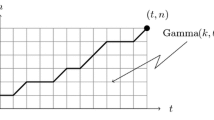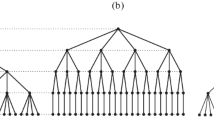Abstract
We study a quenched charged-polymer model, introduced by Garel and Orland in 1988 (Europhys. Lett. 6(7):597–601, 1988; Europhys. Lett. 6(4):307–310, 1988), that reproduces the folding/unfolding transition of biopolymers. We prove that, below the critical inverse temperature, the polymer is delocalized in the sense that: (1) the rescaled trajectory of the polymer converges to the Brownian path; and (2) the partition function remains bounded.
At the critical inverse temperature, we show that the maximum time spent at points jumps discontinuously from 0 to a positive fraction of the number of monomers, in the limit as the number of monomers tends to infinity.
Finally, when the inverse temperature is large, we prove that the polymer collapses in the sense that a large fraction of its monomers live on four adjacent positions, and its diameter grows only logarithmically with the number of the monomers.
Our methods also provide some insight into the annealed phase transition and at the transition due to a pulling force; both phase transitions are shown to be discontinuous.
Similar content being viewed by others
References
Asselah, A.: Annealed lower tails for the energy of a charged polymer. J. Stat. Phys. 138(4–5), 619–644 (2010)
Asselah, A.: Annealed upper tails for the energy of a charged polymer. Ann. Inst. Henri Poincaré Probab. Stat. 47(1), 80–110 (2011)
Bolthausen, E., Schmock, U.: On self-attracting d-dimensional random walks. Ann. Probab. 25(2), 531–572 (1997)
Brydges, D.C., Slade, G.: The diffusive phase of a model of self-interacting walks. Probab. Theory Relat. Fields 103(3), 285–315 (1995)
Chen, X.: Limit laws for the energy of a charged polymer. Ann. Inst. Henri Poincaré Probab. Stat. 44(4), 638–672 (2008)
Chen, X., Khoshnevisan, D.: From charged polymers to random walk in random scenery. In Optimality: The 3rd E.L. Lehmann Symposium, IMS Lecture Notes Monogr. Ser., vol. 57, pp. 237–251 (2009)
Comets, F., Shiga, T., Yoshida, N.: Probabilistic analysis of directed polymers in a random environment: a review. In: Stochastic Analysis on Large Scale Interacting Systems. Adv. Stud. Pure Math., vol. 39, pp. 115–142. Math. Soc. Japan, Tokyo (2004)
den Hollander, F.: Random Polymers. Lecture Notes in Mathematics, vol. 1974. Springer, Berlin (2009). Lectures from the 37th Probability Summer School held in Saint-Flour, 2007.
Derrida, B., Griffiths, R.B., Higgs, P.G.: A model of directed walks with random self-interactions. Europhys. Lett. 18(4), 361 (1992)
Derrida, B., Higgs, P.G.: Low-temperature properties of directed walks with random self interactions. J. Phys. A, Math. Gen. 27(16), 5485 (1994)
Garel, T., Orland, H.: Chemical sequence and spatial structure in simple models of biopolymers. Europhys. Lett. 6(7), 597–601 (1988)
Garel, T., Orland, H.: Mean-field model for protein folding. Europhys. Lett. 6(4), 307–310 (1988)
Giacomin, G.: Random Polymer Models. Imperial College Press, London (2007)
Golding, I., Kantor, Y.: Two-dimensional polymers with random short-range interactions. Phys. Rev. E 56(2), R1318–R1321 (1997)
Hu, Y., Khoshnevisan, D.: Strong approximations in a charged-polymer model. Period. Math. Hung. 61(1–2), 213–224 (2010)
Jain, N., Pruitt, W.: Lower tail probability estimates for subordinators and nondecreasing random walks. Ann. Probab. 15(1), 75–101 (1987)
Kantor, Y., Kardar, M.: Polymers with random self-interactions. Europhys. Lett. 14(5), 421 (1991)
Khoshnevisan, D.: A discrete fractal in \(\textbf{Z}^{1}_{+}\). Proc. Am. Math. Soc. 120(2), 577–584 (1994)
Kingman, J.F.C.: The ergodic theory of subadditive stochastic processes. J. R. Stat. Soc. B 30, 499–510 (1968)
Kingman, J.F.C.: Subadditive ergodic theory. Ann. Probab. 1, 883–909 (1973). With discussion by D.L. Burkholder, Daryl Daley, H. Kesten, P. Ney, Frank Spitzer and J.M. Hammersley, and a reply by the author
van der Hofstad, R., König, W.: A survey of one-dimensional random polymers. J. Stat. Phys. 103(5–6), 915–944 (2001)
Author information
Authors and Affiliations
Corresponding author
Additional information
Research supported by NSF grants DMS-0706728 and DMS-1006903.
Rights and permissions
About this article
Cite this article
Hu, Y., Khoshnevisan, D. & Wouts, M. Charged Polymers in the Attractive Regime: A First-Order Transition from Brownian Scaling to Four-Point Localization. J Stat Phys 144, 948 (2011). https://doi.org/10.1007/s10955-011-0280-1
Received:
Accepted:
Published:
DOI: https://doi.org/10.1007/s10955-011-0280-1




